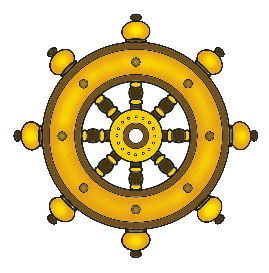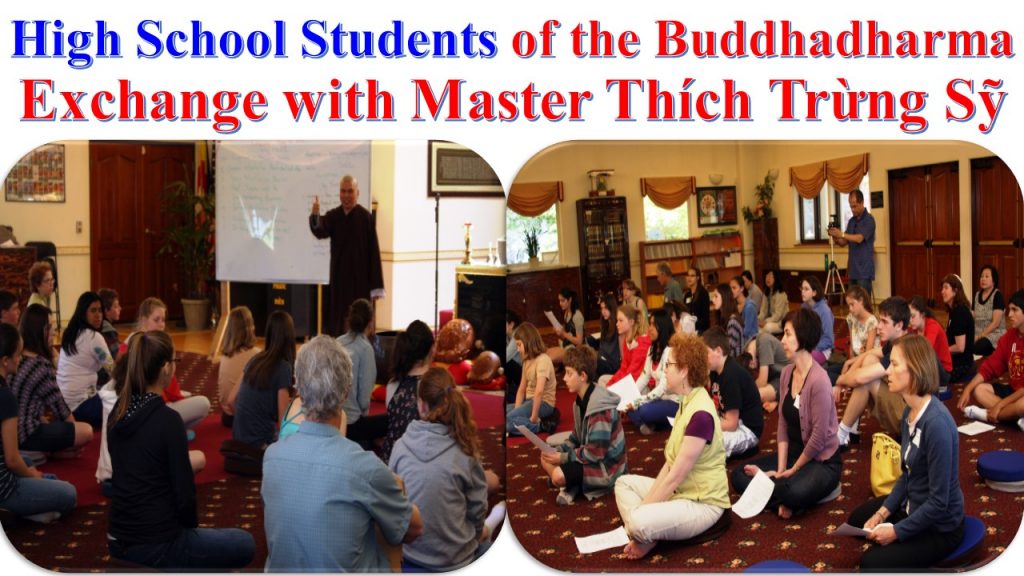
Please see the following readings and pictures happily.
On Sunday, a couple of weeks after the Vesak Celebration,[1] in the City of Seattle, Washington State, the teacher Singer Beth guided about 25 high school students to Cổ Lâm Temple to exchange spiritual culture and learn more about the Buddhadharma under the instruction of Master Thích Trừng Sỹ. Among those students, there were several students accompanied by their parents. Ms. Singer Beth, a co-senior Rabbi of Temple Beth Am, is a teacher of high school and college in Seattle. Although she is the Rabbi, she enjoys studying and learning about the Buddhadharma. She said, “Those who have enough good opportunity to approach, learn about, practice, and to apply the Buddha Dharma in their daily lives have the ability to bring flowers and fruits of joy and happiness to themselves and to others right in the present life.”
Dear Teachers, Parents, and Students,
Today, with the sufficiency of wholesome conditions, we are present at Cổ Lâm Buddhist Temple to learn about and to exchange the Buddha’s teachings. During this exchange, I, Dharma name is Venerable Thích Trừng Sỹ, will instruct you all how to greet each other in the Buddhadharma, how to read the Three Refuges[2] in Pāli and in English, how to understand and to practice the Five Awakening things. After that, I will briefly instruct you how to sing a happy song in Meditation Practice.
1/ How to greet in the Buddhadharma
First, I would like to instruct you on how to put your hands and bow together. The meanings of putting your hands together mean “A lotus for you, a Buddha-to-be.” When both persons put their hands and bow together, the putting of your hands together means both persons have the same wishes to water the seeds of the Buddhadharma, joy, and happiness to sprout and to rise up freshly in your minds.
2/ Reading the Three Refuges in Pàli
1. Buddhaṃ saraṇaṃ gacchāmi
Buddha is a noun; in Vietnamese, we say “Phật” – the Fully Awakened or Enlightened One. Sarana, a noun means refuge or return. Gacchami, a verb, means to go to. In Pāli, both Buddha(m) and Sarana(m) that are the accusative or the second accusative make objects of the verb Gacchami. “I” (Aham) is a pronoun of the first person singular which is tacitly understood to be the subject of the sentence Buddhaṃ saraṇaṃ gacchāmi. Mi in the verb gacchāmi is divided according to the pronoun Aham.[3]
Thus, Buddhaṃ saraṇaṃ gacchāmi means for refuge, I go to the Buddha, who has shown the path of peace, joy, and happiness to living things and living beings all over the planet, or, taking refuge in the Buddha, I have the direction of going mindfully, stably, and lucidly for me in life.
The Buddha means the perfect Awakened and Enlightenment One, who lives his life of mindfulness and awareness, stableness and freedom, peaceful joy and happiness for the many all over the planet. In the Path of Purification (Visuddhimagga),[4] the Buddha has the ten noble titles written as follows:
The World-Honored Buddha;
the Master is our peaceful, noble, and spiritual Leader;
the Master is the most worthy to be made offerings;
the Master understands and loves;
the Master has fully virtuous conduct and insight;
the Master has obtained perfect peace, joy, and deliverance;
the Master understands the world clearly;
the Master has the ability to subjugate people;
the Master of both gods and human beings;
the Master has attained enlightenment and awakening completely;
the Master deserves to be best honored and respected in the world.
A verse of praising the Buddha as follows:
“The Buddha, the Master, showing the peaceful way,
Is the Fully-Awakened One,
With good, noble, respectable signs,
With perfect wisdom and compassion.”[5]
2. Dhammaṃ saraṇaṃ gacchāmi
Dhamma is a noun that means the Buddha’s teachings. Sarana, a noun, means refuge or return. Gacchami, a verb, means go or go to. In Pāli, both Dhamma(m) and Sarana(m) that are the accusative or the second accusative make objects of the verb Gacchami. “I” (Aham) is a pronoun of the first person singular which is tacitly understood to be the subject of the sentence Dhammaṃ saraṇaṃ gacchāmi. Mi in the verb gacchāmi is divided according to the pronoun Aham.[6]
Thus, Dhammaṃ saraṇaṃ gacchāmi means I take refuge in the Dhamma, the path of peace, joy, and happiness for the many right in the present life. Or, taking refuge in the Dhamma in myself, I have the direction of going mindfully, stably, and lucidly for me in life.
The Dhamma has many meanings such as the law of the universe, nature, cause, and effect, phenomenon, etc. In this article, the Dhamma discussed here is understood as the Three Passionless Studies (Ethics, Meditation, and Wisdom) or the noble path with the eight factors including: “Right view, right thought, right speech, right action, right livelihood, right effort, right mindfulness, and right concentration.”
The noble path with the eight factors including Ethics, Meditation, Wisdom is the path of peace, joy, and happiness. This path has many interdependent relations with other tenets of Buddhism, those of other theories and philosophies in the world. This path, understood figuratively, means when we apply and practice the Buddhadhamma in our daily lives, we have the ability to contribute to bringing peaceful joy and happiness to families, schools, and societies all over the planet.
In the Path of Purification (Visuddhimagga),[7] the Dhamma has the ten noble titles defined as follows:
The Dharma of the World-Honored One that has been well proclaimed by himself
Is very practical in the present,
has value beyond time,
has the ability to transform one’s body and mind,
has the ability to extinguish afflictions of greed, anger, delusion, arrogance, doubt, wrong view, etc.
Taking refuge in the Dharma, an intellectual one who can also cultivate oneself masters the Dharma,
comes and sees,
comes and hears,
comes and understands,
comes and learns
comes and practices,
comes and enjoys the flowers and fruits of peaceful joy and happiness right here and right now in the present life.
A verse of praising the Dhamma as follows:
“The Dhamma that is the bright path,
Leads people to escape from a realm of delusion,
Takes me back to my pure mind,
In order to live a life of awakening.”[8]
3. Saṅghaṃ saraṇaṃ gacchāmi
Sangha, a common noun, means the Buddha’s disciples, that is, the Sangha body, Sangha eye, the Community, the Congregation consisting of four or more people. Sarana, a noun, means refuge or return. Gacchami, a verb, means go or go to. In Pāli, both Sangha(m) and Sarana(m) that are the accusative or the second accusative make objects of the verb Gacchami. “I” (Aham) is a pronoun of the first person singular which is tacitly understood to be the subject of the sentence Saṅghaṃ saraṇaṃ gacchāmi. Mi in the verb gacchāmi is divided according to the pronoun Aham.[9]
Thus, Saṅghaṃ saraṇaṃ gacchāmi means I take refuge in the Sangha, the Community of people, who vow to live their lives of peace, harmony, joy, and awakening for myself and for other people, or, taking refuge in the Sangha in my heart, I have the direction of cultivation, peaceful joy, and happiness for myself and for others right here and right now in the present life.
Sangha discussed here relates to the Community of cultivation, peacefulness, harmony, and solidarity of monastics or the Community of lay people. Both of these Communities complement and support one another as image and its shadow, as water and its wave, and together apply the Buddhadharma into their lives to help life more joyful and less suffering.
In the Path of Purification (Visuddhimagga),[10] the Dhamma has the ten noble titles defined as follows:
The Sangha Jewels of the World-Honored One means the Community is going on the really good, true, honest, beautiful, and appropriate path;
the Community following the Buddhadharma practices the Buddhadharma, and lives correctly with the Buddhadharma.
In the noble Community, there are those who have attained and are attaining the holy fruition of the stream-enterer, the once-returner, the non-returner, and that of Arahant, comprise four pairs and eight fruitions of holy people, accomplish all aspects of ethics, meditation, wisdom, deliverance, and deliverance with right understanding.
This Community, deserving to be taken refuge in, served, respected, honored, admired, and made offerings, is the field of merit good for everyone to sow and to plant.[11]
A verse of praising the Sangha as follows:
“The Sangha that are the beautiful Community
Together travel on the happy path
Cultivate and lead to freedom
In order to make life peaceful.”[12]
Through what is discussed above, we see the Three Jewels (the Buddha, the Dhamma, and the Sangha) exemplified as the lamps of insight illuminating our travel on the path of spiritual peace, joy, and happiness. Those who have enough good opportunity to cultivate, to learn, to practice, and to apply the Buddhadharma in their daily lives diligently, then in the present, they live very peacefully, and in the future, they live very joyously.
“Disciples who take refuge in the Triple Gem
On the way of learning the Dharma
Know the Triple Gem of their own hearts
Vow to cultivate and practice diligently
Make their hearts brightened by the three precious Pearls.”[13]
Next to the Buddhadharma, we further understand the Five Awakening Things, whose contents include the Five Precepts or the Five Moral Things below as follows:
The Five Awakening Things
The Five Awakening Things understood as the Five Moral Things, are the teachings of the Buddha, and the direction of going clearly, stably, and peacefully to human beings and societies today. To make it easier for viewers, readers, and learners to understand, grasp, and practice the Five Awakening things, the writer will summarize the following:
1) Respecting lives, developing compassion and loving-kindness, protecting the natural environment, and nourishing inner peace by being aware not to kill living beings.
2) Letting go of the stingy and greedy mind, expressing the mind of almsgivings, making offerings, and protecting the Triple Gem by being aware not to take what is not given.
3) Building happiness for the family, living legally faithfully with a spouse by being aware of not sexual misconduct, adultery, and not violating kids’ sexuality.
4) Saying the true, harmonious, loving, and pleasant words, bringing mutual trust by being aware not to tell lies.
5) Protecting vigorous health, lucid mind, bringing peaceful joy and happiness for families, schools, and societies by being aware not to take alcohols, drugs, including smoking, gambling, online violent video games. When aware to keep far away from these toxins, Dharma learning, Dharma practice, Dharma joy, and Dhamra happiness have the ability to instill and cool the body and mind.
Happiness Song in Meditation Practice
While applying meditation practice, we can practice sitting meditation, breathing meditation, walking meditation, etc. For the events of today’s activity to be more lively, I would like to invite you all to sing a happiness song together.
“Happiness is here and now
I have dropped my worries
Nothing to do, nowhere to go
No longer in a hurry.
Happiness is here and now
I have dropped my worries
Something to go, somewhere to go
But there is no need to hurry.”[14]
Through what the Buddhadharma was exchanged above, although we have about one hour and a half of exchanging the Dharma with the teachers, students, and students’ parents, today’s Dharma sharing session is capable of nurturing and watering the fresh and peaceful seeds that were permeated deeply in our bodies and minds.
May you all be well and happy in the Dharma.
By Thích Trừng Sỹ





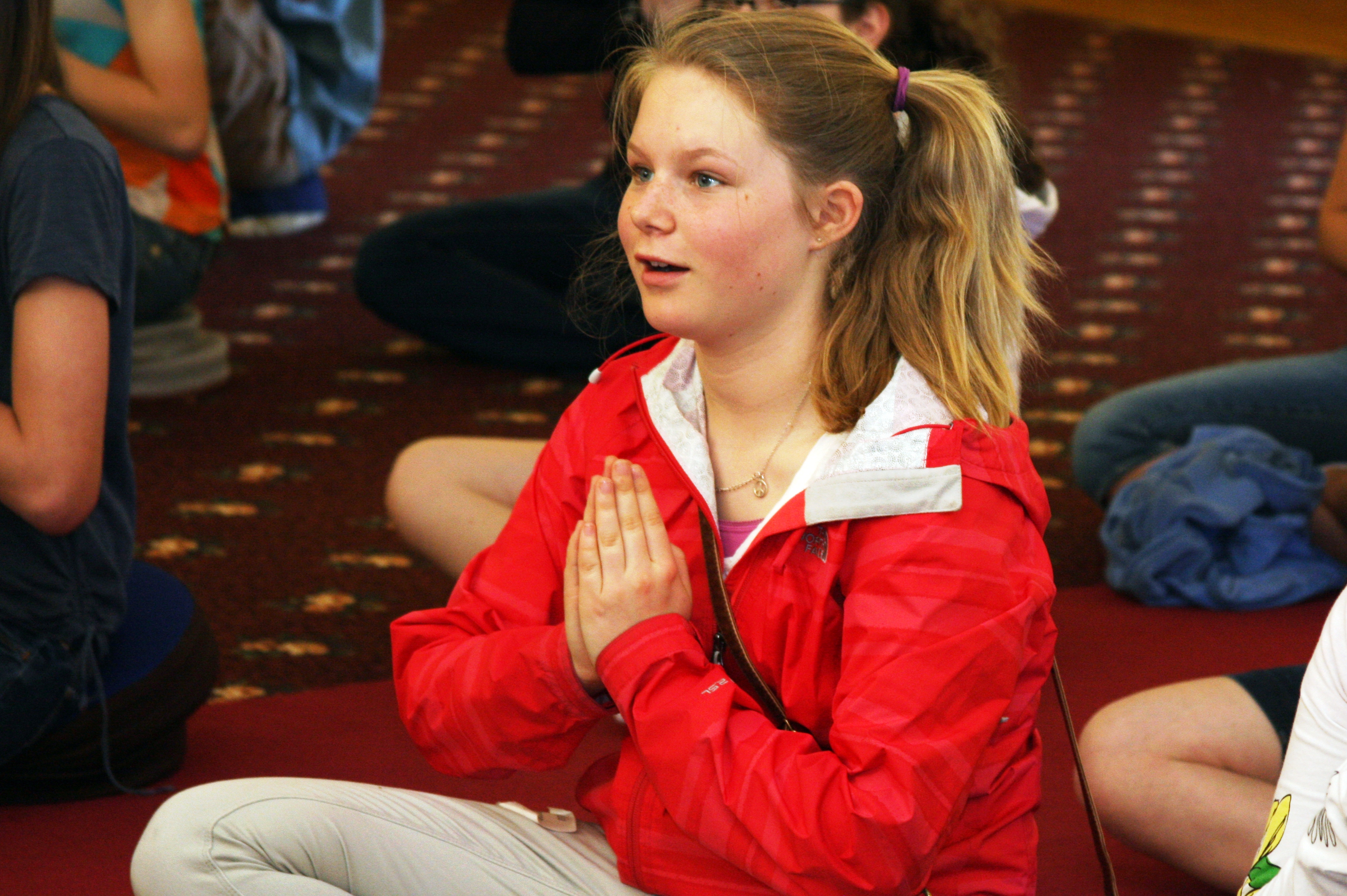

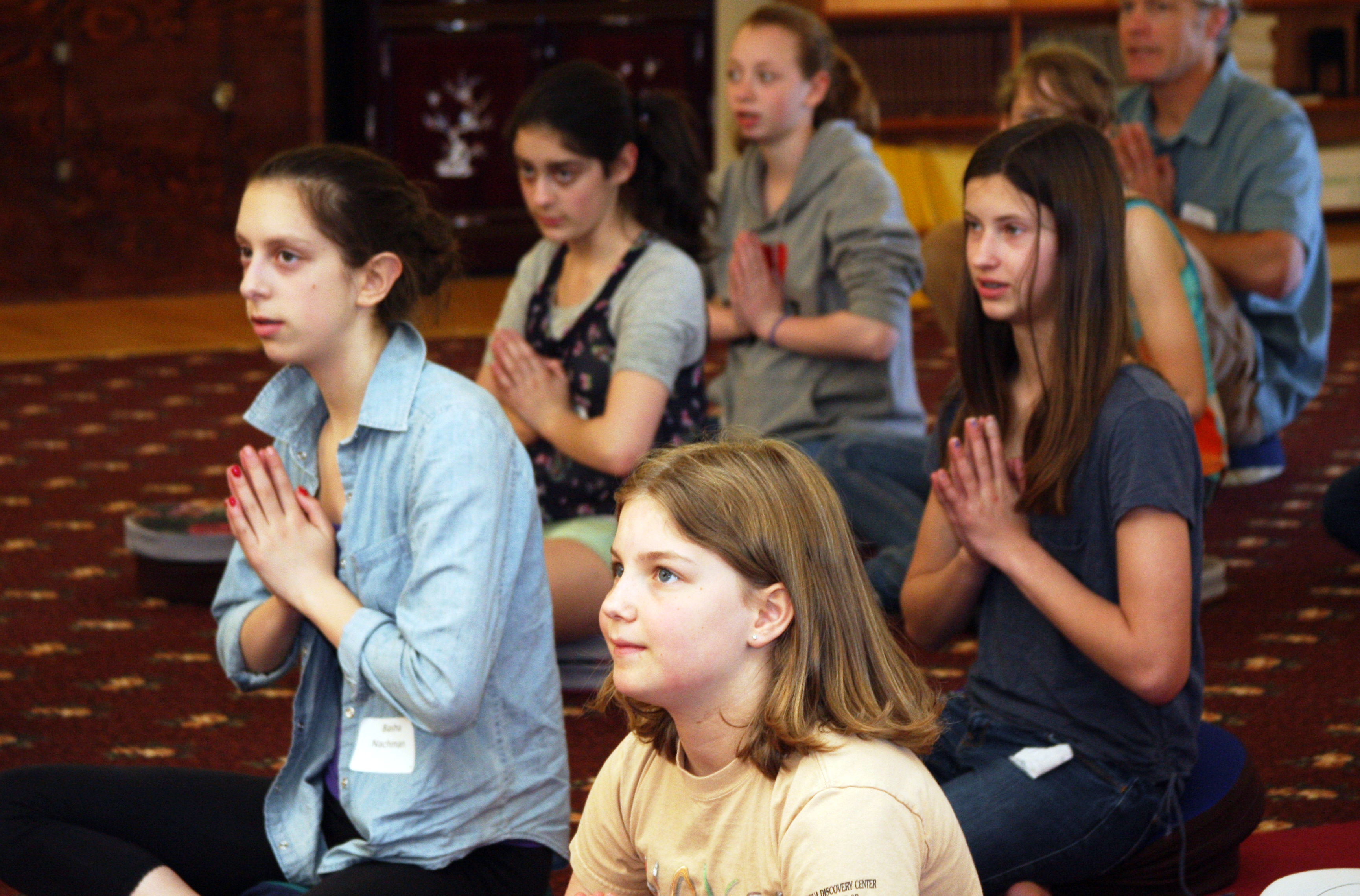



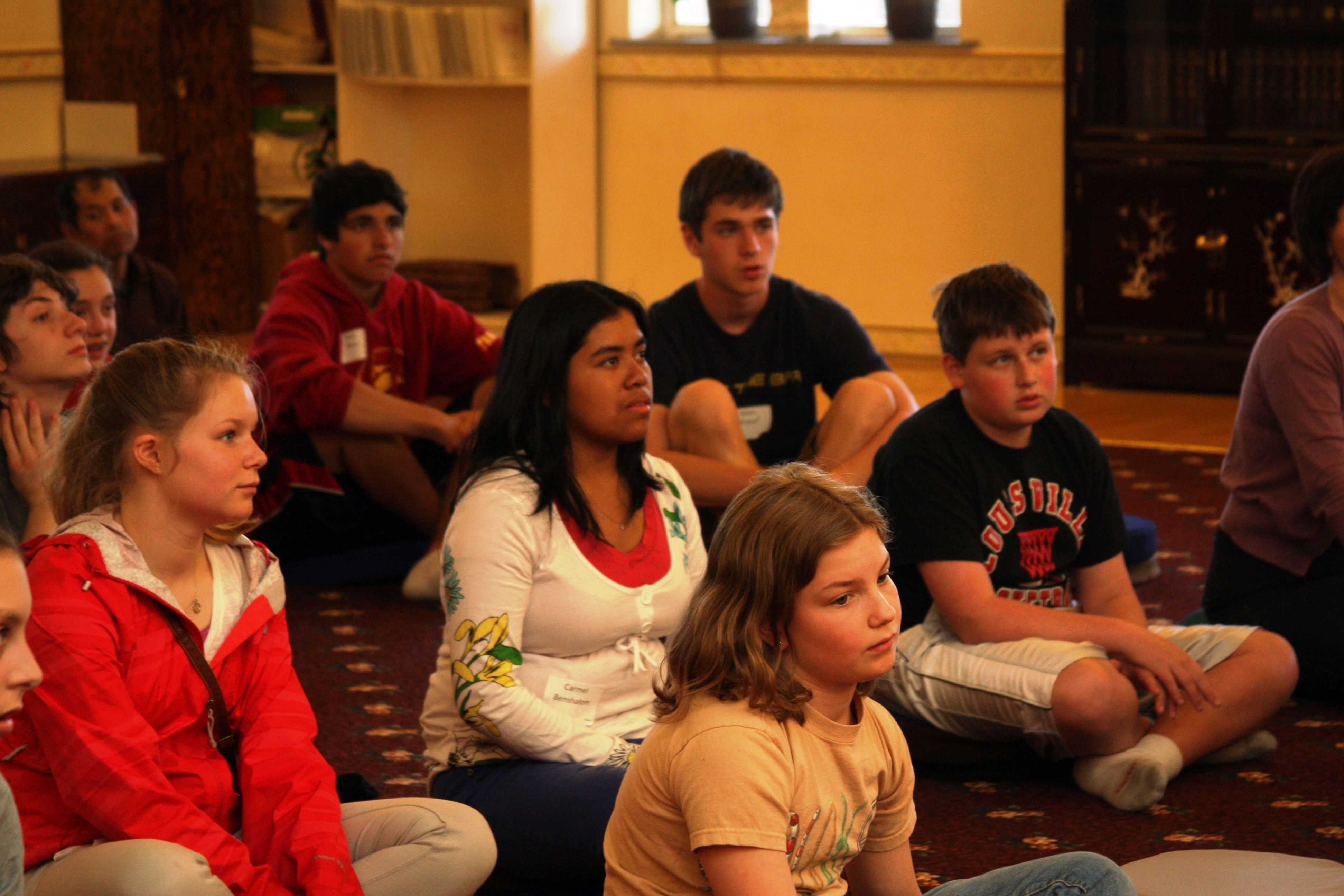









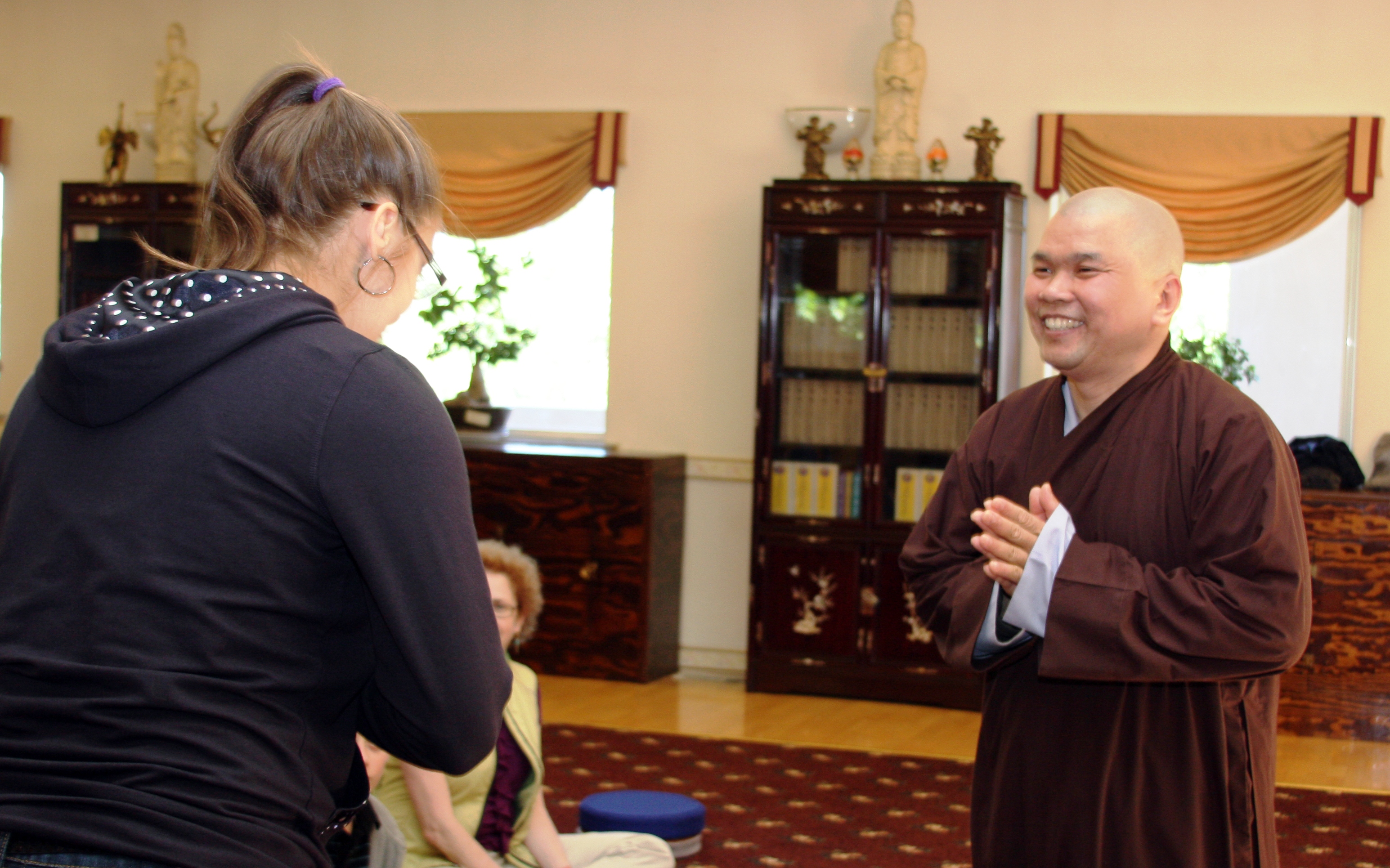















[1] 2636 – 2012
[2] The three Refuges are found in the Dhammacakkappavattana Sutta (Setting the Dharma Wheel in motion) of Samyutta Nikaya (the Connected Discourses of the Buddha), 56: 11. In the Deer Park (Sarnath, Migadāya), the five brothers of Elder Kondanna and other disciples had the good opportunity to see the Buddha, to hear, and to instill the Dharma, they would like to invite him to make their Teacher by reading up the Three Refuges of Triple Gem: The Buddha, the Dharma, and the Sangha. After that, they became the Buddha’s disciples.
[3] http://www.urbandharma.org/pdf/paligram.pdf pp. 68 or 86-7
[4] http://www.aimwell.org/assets/PathofPurification2011.pdf
Part II, Chapter VII, pp. 188 – 209.
[5] Zen Master Thích Nhất Hạnh’s ceremonial Verse.
http://langmai.org/phat-duong/thien-mon-nhat-tung/cong-phu-sang-thu-hai
[6] http://www.urbandharma.org/pdf/paligram.pdf pp. 68 or 86-7.
[7] http://www.aimwell.org/assets/PathofPurification2011.pdf
Part II, Chapter VII, pp. 209 – 215.
[8] Zen Master Thich Nhat Hanh’s ceremonial verse,
http://langmai.org/phat-duong/thien-mon-nhat-tung/cong-phu-sang-thu-hai
[9] http://www.urbandharma.org/pdf/paligram.pdf pp. 68 or 86-7.
[10] http://www.aimwell.org/assets/PathofPurification2011.pdf
Part II, Chapter VII, pp. 215 – 218.
[11] http://www.aimwell.org/assets/PathofPurification2011.pdf
Part II, Chapter VII, pp. 215 – 218.
[12] Zen Master Thích Nhất Hạnh’s ceremonial verse
[13] As above.
[14]http://www.youtube.com/watch?v=e2Te53Vvzn0&feature=related

